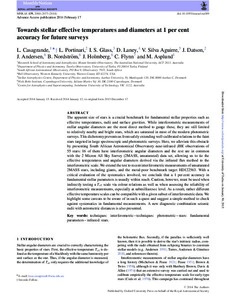Towards stellar effective temperatures and diameters at 1 per cent accuracy for future surveys
L. Portinari; J. Holmberg; J. Andersen; C. Flynn; I.S. Glass; J. Datson; V. Silva Aguirre; M. Asplund; B. Nordström; D. Laney; L. Casagrande
https://urn.fi/URN:NBN:fi-fe2021042715283
Tiivistelmä
The apparent size of stars is a crucial benchmark for fundamental stellar properties such as effective temperatures, radii and surface gravities. While interferometric measurements of stellar angular diameters are the most direct method to gauge these, they are still limited to relatively nearby and bright stars, which are saturated in most of the modern photometric surveys. This dichotomy prevents us from safely extending well-calibrated relations to the faint stars targeted in large spectroscopic and photometric surveys. Here, we alleviate this obstacle by presenting South African Astronomical Observatory near-infrared JHK observations of 55 stars: 16 of them have interferometric angular diameters and the rest are in common with the 2 Micron All Sky Survey (2MASS, unsaturated) data set, allowing us to tie the effective temperatures and angular diameters derived via the infrared flux method to the interferometric scale. We extend the test to recent interferometric measurements of unsaturated 2MASS stars, including giants, and the metal-poor benchmark target HD122563. With a critical evaluation of the systematics involved, we conclude that a 1 per cent accuracy in fundamental stellar parameters is usually within reach. Caution, however, must be used when indirectly testing a Teff scale via colour relations as well as when assessing the reliability of interferometric measurements, especially at submilliarcsec level. As a result, rather different effective temperature scales can be compatible with a given subset of interferometric data. We highlight some caveats to be aware of in such a quest and suggest a simple method to check against systematics in fundamental measurements. A new diagnostic combination seismic radii with astrometric distances is also presented.
Kokoelmat
- Rinnakkaistallenteet [19207]
